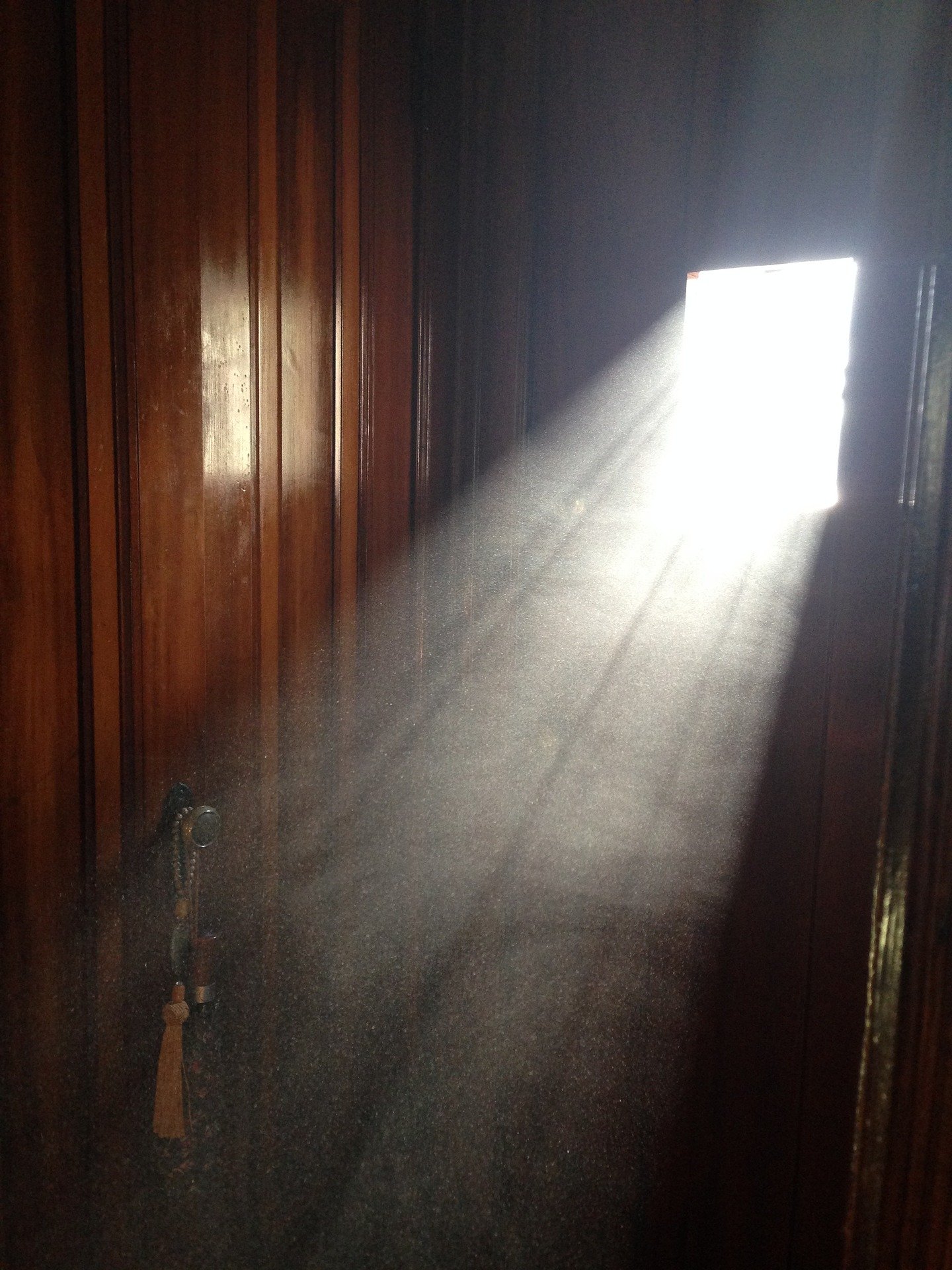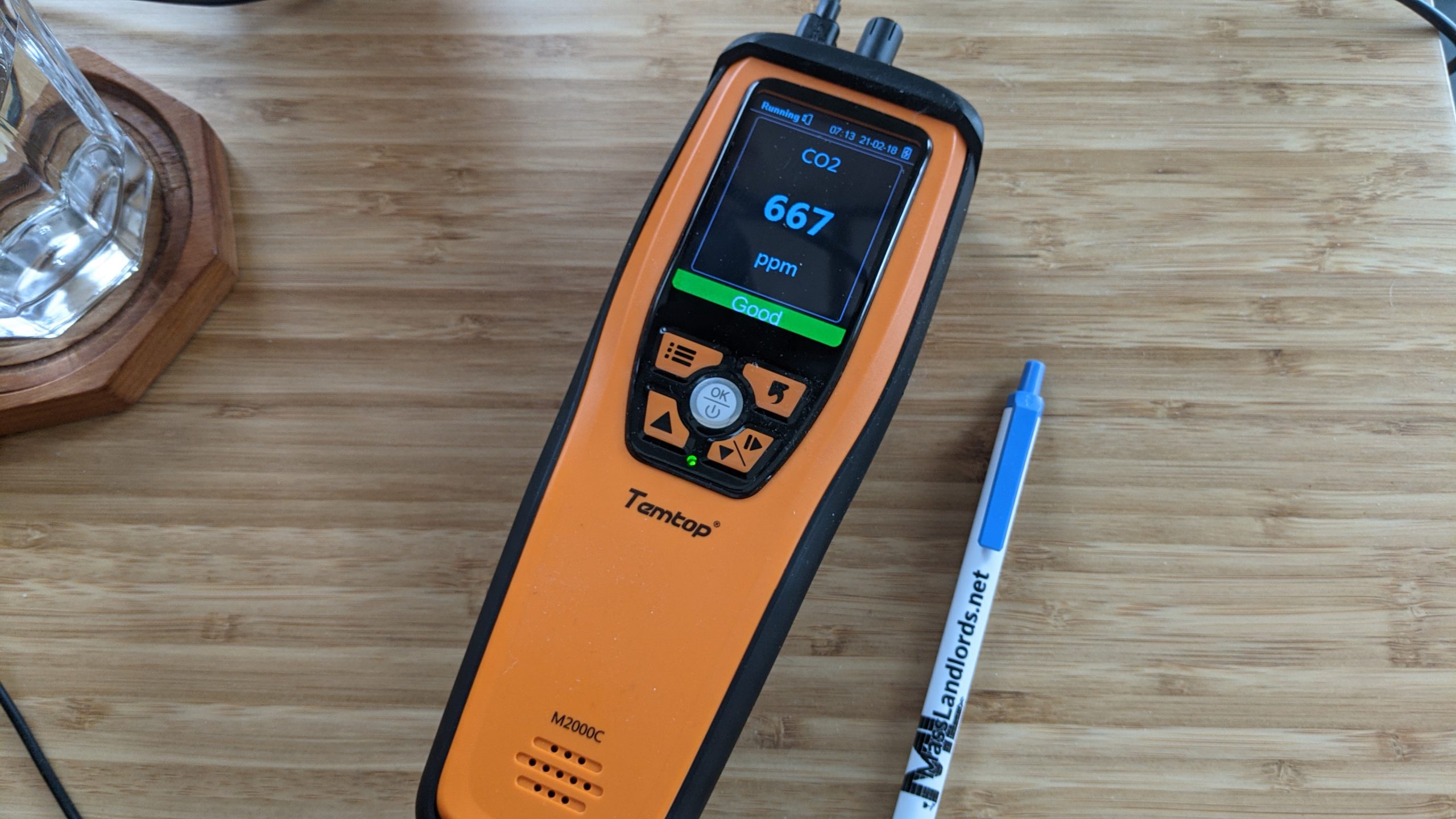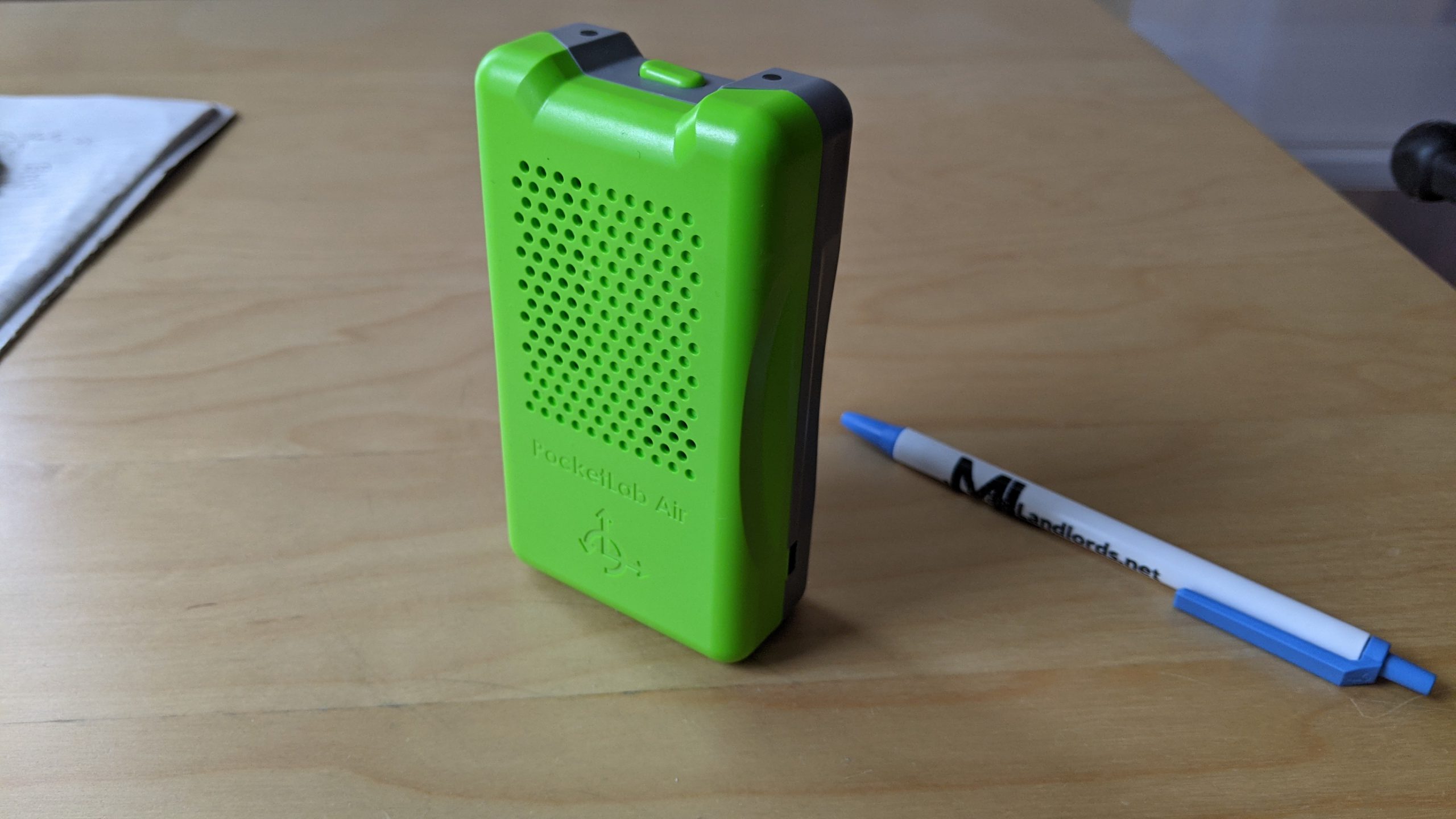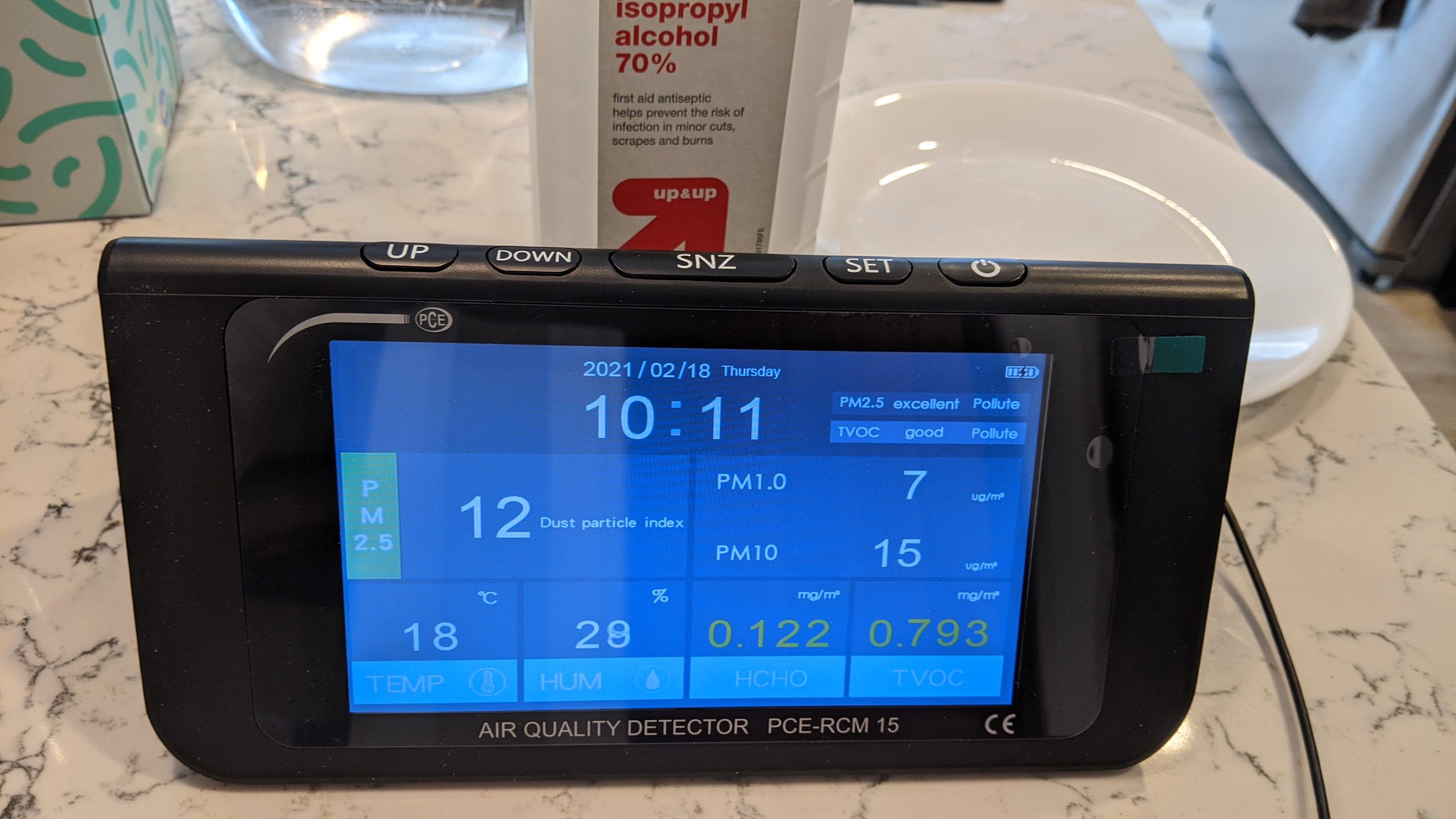The Air We Breathe – How to Measure and Manage Indoor Air Quality in Rentals
| . Posted in News - 0 Comments
By Eric Weld, MassLandlords, Inc.
Indoor air quality and indoor air pollution have become hot-button issues over the past 20 years for several reasons. Indoor air quality affects our health in countless ways, and more people are spending more time inside, breathing the air.
Jump To

Most house mold won’t grow to this extreme version of highly harmful black mold. But even minor mold growth, hiding in damp corners, can detrimentally affect indoor air quality. Image: cc by-sa flickr
Advances in energy-efficient construction have, ironically, had negative impact on indoor air in many buildings by tightening homes and other built structures, in an effort to retain more heated and cooled air inside. As a result, more pollutants are trapped inside too. Increased usage of synthetic materials has also contributed to the problem. Now, reliance on well-operating ventilation and air systems to circulate healthy air has become more pronounced.
According to the Environmental Protection Agency (EPA), between 33% and 50% of commercial buildings in the U.S. have poor indoor air quality, resulting in more than 10 million lost work days a year.
The coronavirus pandemic of 2019 to 2022 heightened the emphasis on indoor air circulation as well, amid uncertainties of the transmission of the virus and how many of the particles were wafting through the air at any given time.
The increased awareness of indoor air quality (IAQ) has drawn closer scrutiny of rental housing conditions, and intensified the responsibility for landlords to provide suitable indoor environments.

Breathing dust at the level shown here, can be very damaging to lung and respiratory functions. Often it takes a dust monitor or streaming sunshine through a window to illuminate the buildup of indoor dust. Image cc by-sa pixabay
A Right to Clean Air
The importance of having access to healthy, breathable air inside the dwellings that we live in and rent hardly needs to be pointed out. Americans spend, on average, 90% of our time indoors. The air we breathe in our homes dictates our quality of life because it so heavily affects our health.
“Because no matter who we are or where we come from,” declared human rights advocate Martin Luther King III, “we’re all entitled to the basic human rights of clean air to breathe, clean water to drink, and healthy land to call home.”
That’s hard to argue.
But what, exactly, is clean, healthy indoor air? And where do landlords’ responsibilities in providing healthy indoor air begin and end?
These questions, and their amorphousness, underscore the difficulty of managing, enforcing, legislating and litigating the subject of IAQ. Sources of and contributors to bad indoor air are so disparate and diverse, it’s difficult to define what quality indoor air is.
The EPA describes IAQ as “the air quality within and around buildings and structures, especially as it relates to the health and comfort of building occupants.” This necessarily general definition is too vague to be usefully applied to landlord-tenant, court and legislative disputes.
Further complicating the issue is the relative subjectivity of breathable air. Air quality for you might not mean the same thing as it does for your tenants, or from one tenant to another. Some people don’t mind, or even think about, regularly inhaling pet dander, cigarette or marijuana smoke, or perfume. Others can become ill by such pollutants.
IAQ According to the State Sanitary Code
It’s a landlord’s duty and legal mandate to provide a suitable dwelling for habitability as defined, at minimum, by the state sanitary code, formally known as Minimum Standards of Fitness for Human Habitation (105 CMR 410). The state sanitary code is typically enforced by local health departments and boards. In Boston, the code is enforced by the Housing Inspection Department.
The state sanitary code details general requirements for indoor air quality. The code provides sections specific to several sources of compromised IAQ, including proper venting of space heaters (105 CMR 410.202), natural and mechanical ventilation (410.280), asbestos containment (410.353), smoke detection and carbon monoxide detectors (410.482), prohibition of lead paint (410.502), extermination of insects, rodents and skunks (410.550), storage of garbage and rubbish (410.600) and maintenance of garbage- and rubbish-free spaces (410.602).
In addition, federal law requires disclosure to renters and prospective home buyers about the presence of lead paint on the property. Massachusetts (and California) law also requires that residents be notified before any pesticides are used indoors.
And, most municipalities maintain their own specific regulations pertaining to habitable dwellings. Many local housing codes are based on a 20th-century model developed by the Center for Disease Control and the American Public Health Association.
Beyond the Sanitary Code
The sanitary code specifically regulates indoor air quality, with sections addressing asbestos, lead paint, garbage and pests. But there is a long list of IAQ inhibitors that are outside the sanitary code and federal and local regulations, some of which are landlords’ responsibility.
Mold is one example, though changes to the sanitary code pending as of 2020, now adopted, changed emphasis to "excess moisture" or humidity. The code as written includes requirements for proper ventilation and mitigation of excess moisture, two measures that can minimize mold conditions. There is no law mandating mold-free rentals, but landlords are increasingly vulnerable to litigation, as documented in this article.
Radon, similarly to mold, is not regulated in Massachusetts. This invisible, odorless natural gas is the second-leading cause of lung cancer, yet its detection and management in homes and rentals is not required by law. It is highly recommended, however, that landlords test for radon periodically. Test kits are relatively cheap ($10-$20 at local hardware or home improvement stores). The test is simple and quick, and it might avoid a lawsuit, or even tragedy.
Of course, there are many pollutants that are beyond the responsibility or capability of landlords to control. In some respects, tenants are responsible for the air they breathe in their rentals, when it involves smoking cigarettes, for example, using chemical cleaners, keeping pets clean and groomed, or maintaining a hygienic environment.
Before we go further in defining landlords’ roles in providing clean IAQ, let’s look at an overview and breakdown of potential indoor air pollutants, with some definitions and details.

Detecting CO2 levels inside can be a good overall measure of indoor air quality. Portable devices like the Temtop M2000C are broadly available. Image cc by-sa 4-0 Masslandlords
Source Groups of Indoor Air Pollution
There are three main categories of indoor air pollution: biological, chemical and combustion pollutants.
Biological pollutants
Biological pollutants include pet dander, mold and mildew, dust mites, viruses and bacteria, pests and pollen, among others. Cockroaches can be particularly harmful to indoor air, as they produce allergens in their fecal matter, saliva, skins and body parts that can aggravate asthma and allergic reactions. Even dead cockroaches release allergens in their decaying skin tissue.
Mice and rats are another pest contributor to bad indoor air. The protein in their urine, which can become airborne when it dries, is a potent allergen. And dead rodents in the walls (mice often climb into walls and insulation to die after eating poison from traps) can contaminate the air for weeks.
Still, except for tobacco smoke (a combustible pollutant), this source may be the most manageable.
Pet dander, dust, pollen, bacteria and pests can be managed, to a large extent, with cleaning, disinfecting and exterminating. These can take place on a schedule as intense as necessary depending on the living situation (pets living with you?), location, the season and personal habits.
The most common and challenging biological pollutant – and among the most frequent subjects of IAQ-related landlord-tenant disputes – is mold. One of the most common inhibitors to healthy IAQ, mold can contribute to the development of asthma, allergies and respiratory infections for those who breathe it for protracted periods. Mold thrives in dampness, so controlling relative humidity inside is the key to mitigating mold. A level of 30%–50% humidity is the recommended range inside to minimize mold and mildew conditions. Dust mites and cockroach habitats are also supported by damp environments.
In some cases, a dehumidifier, placed in a damp area, will keep mold, moisture and dust mites in check. There is a wide range of dehumidifiers available, including integrated whole-home systems – for dwellings in which constant dampness is an issue – and numerous portable units that can address specific areas. Dehumidifiers are rated by the capacity of moisture they remove in a given temperature setting. In general, when buying a portable dehumidifier, it’s better to buy a larger one that will run less frequently than to rely on a smaller one running much of the time during high humidity.
Also, you should remove mold-friendly materials in damp areas, such as cardboard boxes, drywall and old wood paneling. Wipe down all surfaces in damp areas with a strong anti-mold and mildew cleaner. Professional mold mitigation will be necessary in some cases.
Chemical pollutants
Our modern world is filled with chemicals for cleaning, building, stripping, gluing, finishing, deodorizing and just living. Even our own breath contains a mixture of volatile organic compounds (VOCs) like carbon dioxide, methanol, ethanol and others that are harmful to human health in concentrated amounts.
Chemical pollutants include VOCs such as lead and radon, but also benzene and toluene that might off-gas from carpet adhesive, and formaldehyde, a toxic chemical in conventional floor sealers, finishes, ceiling tiles, furniture and cabinet materials like pressed wood. Exposure to many VOCs can have adverse long- and short-term impacts on human and pet health. Concentration of VOCs is much higher indoors, as the compounds are emitted by thousands of everyday household, industrial and construction products.
It’s impossible to completely remove chemicals from our interior breathing spaces. But we can certainly reduce harmful chemicals and pollutants in three ways: 1) cutting down on products that contain VOCs, 2) properly ventilating and 3) cleaning the air.
Often, air can be cleansed naturally. Rather than perfuming the air by spraying scented purifier and VOCs into the house, it’s much more effective to determine the source of a pollutive smell – such as decaying cockroach carcasses – and remove it.
There are also many natural products, including air fresheners, on the market, and natural air scents are only as limited as your innovation. Potpourri, cloves, lemons, citrus mixes, cinnamon sticks and unlit candles are all preferable air improvers to chemical “purifiers.” When possible, substitute off-the-shelf air fresheners and cleaners, many of which are full of VOCs, with natural products. Bear in mind a scented candle is no good once lighted: candle flame soot is itself a pollutant.
If you do reach for chemical air cleansers, check the label. Manufacturers are not required to list VOCs by that term on their labels, but you can scan for often-used chemicals that are harmful, such as acetone, benzene and xylene.
One of the best natural ways to eradicate indoor pollutants? Open windows and doors whenever possible. Outside air is usually cleaner than inside air, and creating natural ventilation is free, plentiful and healthy. Keep an eye on the MassAir Outdoor Air Pollution Map to know whether the air outside is actually better. Fires and smog can put us in a difficult trade-off of accepting indoor pollutants over outdoor ones. Most days, outside air will be cleaner.
Good ventilation systems in homes and rentals are more important now than they used to be, because most newer buildings – those built in the past 30 years – are built with higher efficiency standards, for the purpose of keeping more heated and cooled air inside and, inversely, cold or hot, humid air outside. This efficiency is more cost-effective for cooling and heating dwellings, but it also retains more air, and pollutants, inside, and blocks helpful outside air from coming in. According to the Consumer Product Safety Commission, poor IAQ can be found in about 30% of new and remodeled buildings.
Allowing outside air into a dwelling, and forcing bad air out, is an essential role of HVAC systems with strong outdoor intakes. Venting polluted air, through bathroom exhaust fans, overhead stove fans and attic fans, is just as important.
Finally, air purifiers have become popular, particularly during the coronavirus epidemic, but evidence of their efficacy is very mixed. Some lower-priced ionizing air filters may even be harmful to indoor air because they produce ozone. Also, most small air purifiers are simply not powerful enough to clean the spaces in which they are typically used.
Combustion pollutants
Combustion pollutants include any gases or particles produced by burning fuel. They include tobacco smoke and smoke from burning wood, charcoal or natural gas, as well as carbon monoxide and nitrogen dioxide.
These pollutants enter homes and rentals from improperly vented space heaters, stoves, clothes dryers, fireplaces, etc. Venting combustion pollutants to the outside is essential for healthy indoor air.
Carbon monoxide is another odorless, colorless – in other words, nondetectable – toxic gas and is lethal even with brief exposure. Carbon monoxide results from the burning of fuels from cars, stoves, grills, fireplaces and furnaces. More than 400 Americans die every year from carbon monoxide poisoning.
In Massachusetts, Nicole’s Law – named after 7-year-old Nicole Garofalo, who died of carbon monoxide poisoning in 2005 – requires that carbon monoxide alarms be installed in every level of homes containing fossil-fuel burning equipment, including furnaces, boilers, water heaters and fireplaces. That pertains to almost all rentals in Massachusetts.
Cooking with gas
One outsized source of combustion pollutants is the gas stove, which creates heat for cooking by the combustion of natural gas, propane or butane. The use of gas stoves has grown nearly 400% in the United States since 1950, and today about 40 percent of American households use gas stoves. Culinary professionals and aficionados love cooking with gas stoves because the burners afford a high level of heat control. Cooking with gas is also cheaper than using electricity.
Unfortunately, gas stoves emit harmful pollutants into the air, including carbon monoxide, formaldehyde, particulate matter, and most troubling, nitrogen dioxide, all of which contribute to higher levels of respiratory illnesses. An analysis of studies conducted by the International Journal of Epidemiology in 2013 found that children raised in homes with gas stoves have a 42% higher risk of developing asthma symptoms. This statistic aligns with a recent study conducted by Australia's Climate Council, cited in The Age, finding that children living in houses with gas cooktops are 32% more likely to develop asthmas than those who don't. The paper also confirmed findings from a 1992 analysis concluding that children exposed to a level of nitrogen dioxide consistent with gas stove cooking are more vulnerable to respiratory illness.
These statistics align with a recent report, Kicking the Gas Habit: How Gas is Harming Our Health, conducted by Australia's Climate Council, and cited in The Age, which found that children living in houses with gas cooktops are 32% more likely to develop asthma than those who don't. That percentage, the report noted, is similar to that of children who grow up in the house of a smoker.
For many who are used to cooking with gas, going back to electric ranges and ovens is a nonstarter. Rather, the optimal alternative to gas cooking is induction. Induction cooking is faster, more powerful, and gives even more control than gas. Induction range/oven prices are only slightly more expensive than electric and gas products. And induction pan sets are available from $100. (Some landlords have started providing induction pans as move-in gifts to introduce renters to their first induction range.)
With so much information coming to light in the past 10 years about the harm to indoor air caused by gas stoves, and improvements coming quickly in the induction cooking realm, the days of cooking with gas are numbered. That’s a good thing.

Ozone measuring devices like the PocketLab Air offer a convenient, portable device for monitoring not only O3, but also CO2, barometric pressure, particulates and other air qualities. Image cc by-sa 4-0 Masslandlords
Impacts of Bad Indoor Air Quality
Whatever the cause, there is no dispute that bad air inside wields a range of detrimental effects on those who breathe it. The high percentage of time spent inside rises even more for people who are most susceptible to indoor pollutants, such as very young and elderly people, and those with cardiovascular and respiratory diseases. The Institutes of Health Metrics and Evaluation (IHME) estimated 1.8 million deaths in 2012 due to indoor air pollution, as reported in Our World in Data. The World Health Organization (WHO) put the number at 4.3 million deaths worldwide. Wherever the actual number lies, it’s safe to say that poor indoor air quality is responsible for millions of deaths each year. The WHO has called indoor air pollution “the world’s largest single environmental health risk.”
Asthma is one of the most common IAQ-related maladies that has seen a steep incidental rise in the past few decades. Other effects include cardio-pulmonary and respiratory irritation, inflammation, cancer, developmental delays, compromised immunity, and even death in the case of carbon monoxide.
Sick Building Syndrome (SBS) is a modern phenomenon in which people develop poor health symptoms – similar to common cold symptoms – when spending prolonged time in one particular building. The symptoms of SBS dissipate when the sufferer leaves the building and return when they reenter. SBS is difficult to prove, and though poor IAQ is frequently believed to be responsible, the cause is uncertain.
Testing, Testing Indoor Air Quality
Even if there could exist some agreed specificity around a definition of the “health and comfort” of quality air, it’s tricky to test and monitor for all potential bad air sources.
Testing indoor air is most effective when done selectively, for a specific pollutant. There is no all-in-one test because IAQ is so broad and difficult to define. There are certainly IAQ sensors and testing systems available, but they are targeted for specific pollutants or categories of pollutants. Radon tests are one example of such tests, as are legally required carbon monoxide and smoke sensors. Inexpensive test kits are also available for mold.
There is also an assortment of general IAQ monitors on the market that measure levels of temperature, relative humidity, carbon dioxide and particulate matter like smoke and dust. Some monitor VOCs as well.

Tabletop air quality monitors like this are widely available, relatively inexpensive, and provide a convenient way to measure indoor humidity, dust, particulates, temperature and more. Image cc by-sa 4-0 Masslandlords
An IAQ Testing Guide
CO2 monitors
Concentrated levels of carbon dioxide (CO2) can cause tiredness, sleepiness and headaches, and even nausea and dizziness in high levels. At extreme levels, loss of consciousness may occur. CO2 is emitted every time living organisms, such as humans, breathe out, but it’s also a byproduct of fossil fuel combustion.
The detection of CO2 inside can serve as a good barometer of overall IAQ. CO2 sensors and monitors are abundantly available and simple to use. They come in handheld and desktop styles, and are available in a wide range of prices starting at about $80. Inside measurements of CO2 should be below 1000 parts per million (ppm).
Radon testing
The Massachusetts Department of Public Health recommends testing for the potentially deadly gas radon during winter when levels are typically higher. Radon kits are widely available at home improvement stores, and certified radon specialists are available for hire. For a free radon test kit, call the Massachusetts Radon Hotline, 800-723-6695.
Place the test kit in the dwelling’s lowest level where people spend time and follow package instructions for the duration of the test. Run HVAC systems during the test to recirculate inside air, but do not use fireplaces, whole-house fans or other devices that bring in air from outside.
Radon is measured in pinocuries per liter of air (pCi/L). A radon test will ideally measure less than 2 pCi/L. The EPA recommends taking mitigation action for tests between 2 and 4 pCi/L. A reading above 4 requires immediate mitigation.
Testing for VOCs
VOCs have become ubiquitous. Testing for VOC levels is not a simple process, and can be very expensive if done properly. VOCs testing companies, such as AirMD in Boston, can provide thorough lab tests of indoor air samples and provide reliable VOC levels.
Alternatively, air quality monitors in the $200 range claim to measure VOCs inside. These devices can give accurate readings of temperature and humidity, but they typically use a cheap heated metal oxide semiconductor sensor that may not be accurate for measuring VOCs.
Testing for dust
The buildup of dust inside homes, offices and schools poses a serious health risk because dust is made up of a range of particulates, including dirt, skin, hair, clothing, bacteria, dead bugs, pollen and even tiny bits of plastic. When humans breathe in these dust particles, they can lodge inside the body and disrupt respiration and other functions.
Dust monitoring devices proliferate the market in a variety of prices and technologies. Laser scattering measures the concentration of scattering light when a laser hits particle matter. Air particle counters are more practical for home use, and come in handheld, portable and remote models ranging in price from about $90 to several thousand dollars.
Testing for Ozone
We want ozone (O3) in our atmosphere, high in the sky, where it protects us from the sun’s UV rays. But we want to keep an eye on ozone in our interior breathing air, where it can damage lung tissue and reduce lung efficiency.
Industrial ozone measurement devices can be large and cumbersome for home use. But a relatively new device called the PocketLab Air is about the size of a transistor radio and measures ozone, carbon dioxide, particulates, barometric pressure and other air qualities. It lists at $318.
A much cheaper alternative is ozone test strips, which are easy-to-use, chemically treated bands that change colors in reaction to ozone measurements. These come in packages, some less than $1 each.
Is the Landlord Responsible for Indoor Air Quality?
Assigning responsibility for air quality in rentals is another tricky matter. Other than state sanitary code regulations, lead paint, carbon monoxide and smoke sensors, IAQ is largely unregulated. But it would be a mistake to view that as reason not to be vigilant about IAQ in your rentals. Responding to bad indoor air complaints, or worse, waiting around to be sued by tenants, are both far more expensive solutions than taking measures to test and maintain healthy air.
Disputes frequently arise among tenants and landlords around indoor air quality, but healthy IAQ is a collaboration, and people have differing living standards. Often unwittingly, we compromise our air by inviting or allowing an array of pollutants like cigarette smoke, VOCs from cleaning products, aerosol purifiers, hairsprays, perfumes, etc.
The safest route for landlords is to disallow any pets and smoking on the rental property. Not only will that help maintain fresher air for all tenants in the building, it will also save money on cleaning, painting, carpet replacement and odor mitigation.
David Turcotte, a professor at the University of Massachusetts, Lowell, who researches healthy homes and sustainable housing, recently advised MassLandlords members at a virtual meeting on what landlords can do to minimize IAQ-related risk.
Turcotte listed four general steps landlords can take to maintain healthy air in their rentals: 1) minimize the use of pesticides; 2) seal up all holes and entry points of rental buildings to keep pests out; 3) in new structures, use construction materials that minimize exposure to chemicals and dust; and 4) control moisture by employing sound drainage systems, fixing any leaks and reducing dampness.
Indoor Air Quality Conclusion
We’ve come to a point in which outdoor air is much healthier than indoor air. That hasn’t always been the case. Since the Clean Air Act of 1970, which largely focused on reducing outdoor air pollution, key air pollutants have been more than cut in half outside. Meanwhile, indoor air quality has declined precipitously.
We now know that inside air, in many cases, is negatively impacting our health in ways we weren’t considering only a decade ago. And while regulation is slow to respond, consumers are gradually becoming more informed about the pollutants in household products.
Even in the absence of robust regulation of indoor air, it’s in the inherent interest of landlords to provide healthy indoor air for tenants. It’s common knowledge: Healthy, happy tenants are higher quality tenants, better able to provide for themselves economically, pay their rent on time and in full, and remain tenants in good standing for longer, more stable periods.
Healthy, happy tenants make healthy, happy landlords.
Past Presentations
Indoor Air Quality
To view all of this presentation, you must be logged-in and a member in good standing.
Log in or join today and gain access all presentations and videos
Slides are available only for members in good standing who are logged in.




